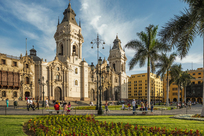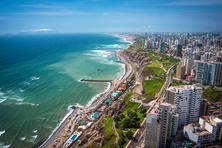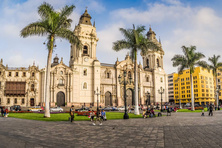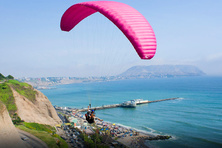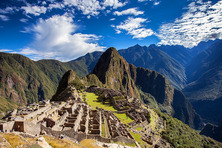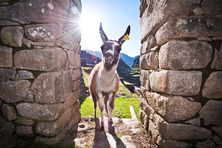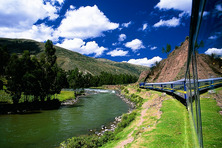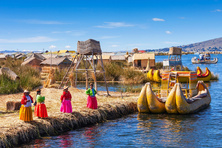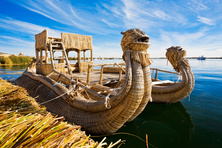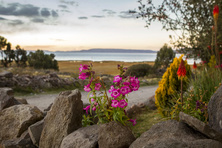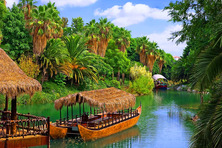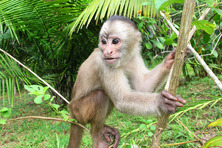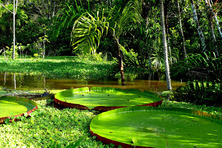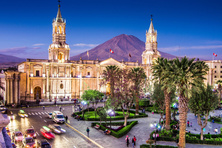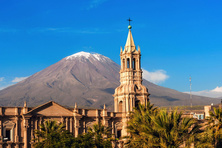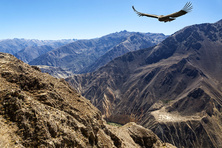Peru
- Capital:Lima
- Currency: Peruvian nuevo sol
- Time: UTC-5
- Languages: Spanish, Quechua, Aymara
- Religions: Christianity (Catholicism, Evangelism)
- Sections: Get in Visa Customs Cuisine Money Details of interest Popular resorts
The Republic of Peru is a unique country on the west coast of South America. It borders Colombia, Ecuador, Chile, Bolivia, and Brazil. The capital city is Lima.
There are three climatic zones in Peru. The cost of Amazon river has a dry desert climate and annual temperature varies from +16°C to +27°C. In the mountains or in Sierra Amazon, the climate is temperate. The temperature here is +4°C in the mountains and +24°C in the valleys. The western part or the Amazon Rainforest has a sub-equatorial climate and frequent rains. The best for visiting the coastal region of Peru is from December to March. We recommend visiting the mountains from June to August.
Half of the population in Peru are the Indians, 35% are the descendants of the white immigrants and mestizos, and 15% are the immigrants from other countries. The majority of the Peruvians are the Catholics. The official languages are Quechua and Spanish.
The lovers of city tourism should start their journey in Lima with its historical and architectural monuments of the Incan and Spanish periods. Trujillo is the city with many monuments of the colonial period and Cusco is a historical city built by the conquistadors on the place of the former Incan settlement. Today Cusco is under UNESCO protection.
In Cajamarca and Arequipa, the tourists can see the buildings in a typical Creole style with the Neo-Gothic and Baroque elements. Arequipa is the centre of the Peruvian cuisine and the main destination for gastronomical tourism. Near Arequipa, there is a famous Colca Canyon, one of the deepest canyons in the world. In Huaca Rajada village near Chiclayo (the fourth largest city in Peru), the tourists can take an excursion to the Sipan Royal Tombs.
Among the must-see places in Peru are Machu Picchu, the Nazca Valley, the Incas Sacred Valley. The cities Ukiah, and Ica are the centres of climbing.
Ecological tourists should visit reserves and national parks in Sierra and Selva. In Peru, extreme tours to the Tambopata Reserve in Puerto Maldonado, Iquitos, which is called A Window of the Amazon, a city of Puno near the Titicaca Lake, and Ancash which is known as the Peruvian Switzerland are arranged.
A seaside town Tumbes is a centre of beach entertainments, boat trips and cruises, yachting, and sailing.
Get in
By Plane
There are no direct flights between CIS and EU countries and Peru. The tourists will have to choose the routes with a transfer in some European airports or in the United States of America.
American airlines Jet Blue and Spirit Airlines offer rather cheap flights to Lima from Miami.
If you prefer a transfer in Europe, choose the services of the following airlines:
- Iberia and Air Europe offer flights to Lima from Madrid;
- KLM offers a route from Amsterdam;
- Air France has a flight from Paris to Lima.
One can get to Peru from Havana with Aeroflot or from Venezuela with Lufthansa.
By Land
There are border crossings between Peru and Columbia, Brazil, Ecuador, and Chile. International buses run regularly between Peru and neighbouring countries.
By Sea
There is an Amazon river crossing on the Santa Rosa Island. It links the country with the Columbian city Leticia and there is an everyday boat to Peru.
Visa
The tourists can travel to Peru and stay there for 183 visa-free. This rule is applied to the citizens of Russia, Belarus, Kazakhstan, Ukraine and other CIS countries and to the travellers from the European Union.
To receive a visitor visa to Peru, the foreigners must provide a bank account statement to the Consulate or the Embassy. The minimal balance of the bank account must be 1.000 sterling pounds (or the same amount in any other currency).
Customs
The tourists can import and export the Peruvian currency without limitations. The Customs legislation of Peru does not have any restrictions concerning the import of any foreign currency, however, the money must be declared. The export of the foreign currency is limited to the sum indicated on the declaration form.
According to the current Customs legislation, the tourists can bring in Peru duty-free perfume, tobacco and alcohol. The total sum of the goods in an original package and classified as personal belongings and gifts must not exceed 300 US dollars.
If the travellers import sausages or cheese, they must provide the manufacturer’s certificate.
It is prohibited to import:
- Items having archaeological, historical or artistic value;
- professional photo and video equipment without a special permission.
If the tourists want to export from Peru leather and woollen goods, jewellery or expensive souvenirs, they must provide a sales receipt. The Customs officers will demand a sales receipt if you export fur goods from Peru.
Cuisine
The national Peruvian cuisine was greatly influenced by the Spanish cooking traditions. A hot stew with beans, lentils, and various types of meat, Papa Relena (mashed potatoes with different fillings), Carapulcra (dehydrated potatoes) – these dishes are a hallmark of Peru.
The Peruvians love meat. The travellers can try Cuy (roasted guinea pig), Puno (alpaca steak) or Pachamanca (barbequed meat). The lovers of hot dishes should try kebabs Anticuchos. It is prepared from marinated lamb, beef or cow’s heart.
In the valley of the Amazon and in the coastal regions, seafood and fish dishes are very popular. We recommend Ceviche (fish marinated with lemon juice) and Sup de Mariscos (a hot seafood soup). In Peru, you can treat yourself to prawns, octopus, crawfish, and a trout from the Peruvian mountain lakes.
Instead of bread, in Peru, you will be served maize flatbread Tamale. Some people will find the Peruvian desserts extremely sweet. For example, the famous Lima meringue Suspiro Limeno contains so much sugar that it is impossible to eat it. One can only lick it slowly as an ice-cream.
In Peru, you should try a local alcoholic beverage Pisco (grape-based white spirit). In Selva, they produce Aquardiente and Kashassa, local versions of herbal-based rum.
You will appreciate the taste of such wines as Vista Alegre, Vino Tinto, and Takama. These wines have been internationally acknowledged. If you prefer beer to wine, treat yourself to local brands Crystal, Cusceno, Trujillaino, and Arequipena.
Traditional Peruvian hot drinks are coca leaves tea, coffee, and mate. Do not leave Peru without trying a traditional fermented beverage of the Indians Chicha.
Money
The official currency of Peru is the Sol (PEN).
The US dollars are in free circulation in Peru. In some shops, the receipts are given with two currencies, the local and the American. However, be aware that if you pay in US dollars, the change is typically given in sols (PEN).
The tourists can exchange the US dollars into sols in hotels, exchange offices and at banks. Other currency can be exchanged only at banks. Keep the receipt you are given for the transaction as you will need it to exchange sols back to other foreign currency.
The ATMs give either national currency or US dollars. There are ATMs in large touristic centres and in small cities. However, if you are going to the hard-to-reach places for extreme tourism, make sure you have enough cash.
Bank cards and traveller’s checks are accepted only in Lima.
It is not common to give tips in hotels, bars, restaurants, and taxi. The sum of a tip is already included on the bill. The exception is the services of local guides. The size of a tip for them is 3-5 US dollars a day.
Details of interest
Sightseeing in Peru
Peru attracts the tourists with its monuments of ancient civilisations (Inca and Pra-Inca), the cities of conquistadors, the Sacred Valley of the Incas and the valley of the Amazon where one can see the third of the world flora and fauna.
Even the experienced travellers will be amazed at the Nazca plateau, Machu Picchu, observatories high in the mountains, and the temples of Incas. The city of Cusco is under UNESCO protection. It was built on the ruins of the Incas buildings.
The Indian road system is also included on the UNESCO World Heritage List. This is a unique site and it contains 30.000 kilometres of paved roads fanning out across the entire country.
The unique Manu National Park, the Huascaran National Park, and the Rio Abiseo National Park preserve the flora and fauna of the Amazon. The tourists can go fishing in Selva, watch the dolphins, gavials, and visit the Indian tribes.
In Piura, the tourists can visit the Plaza de Armas, San Francisco Church, El Carmen Church, and the Admiral Miguel Grau Museum and House. In this resort city, there is the Narihuala Archaeological Site and the Narihuala Fortress. The lovers of surfing and windsurfing gather on the beaches Colan, Los Organos, Mancora, and Cabo Blanco.
Souvenirs in Peru
- Ritual Indian leather, wooden or clay masks and musical instruments are sold in Cusco.
- Copies of things of the pre-Columbian period, ceramic plates with geometric patterns, and mate sets can be bought in Cajamarca.
- In Chiclayo, the tourists can buy the works of the Peruvian artists (scenes from everyday life, city views, ancient architecture).
- In Lima, anyone can find an alpaca carpet or a bedcover.










